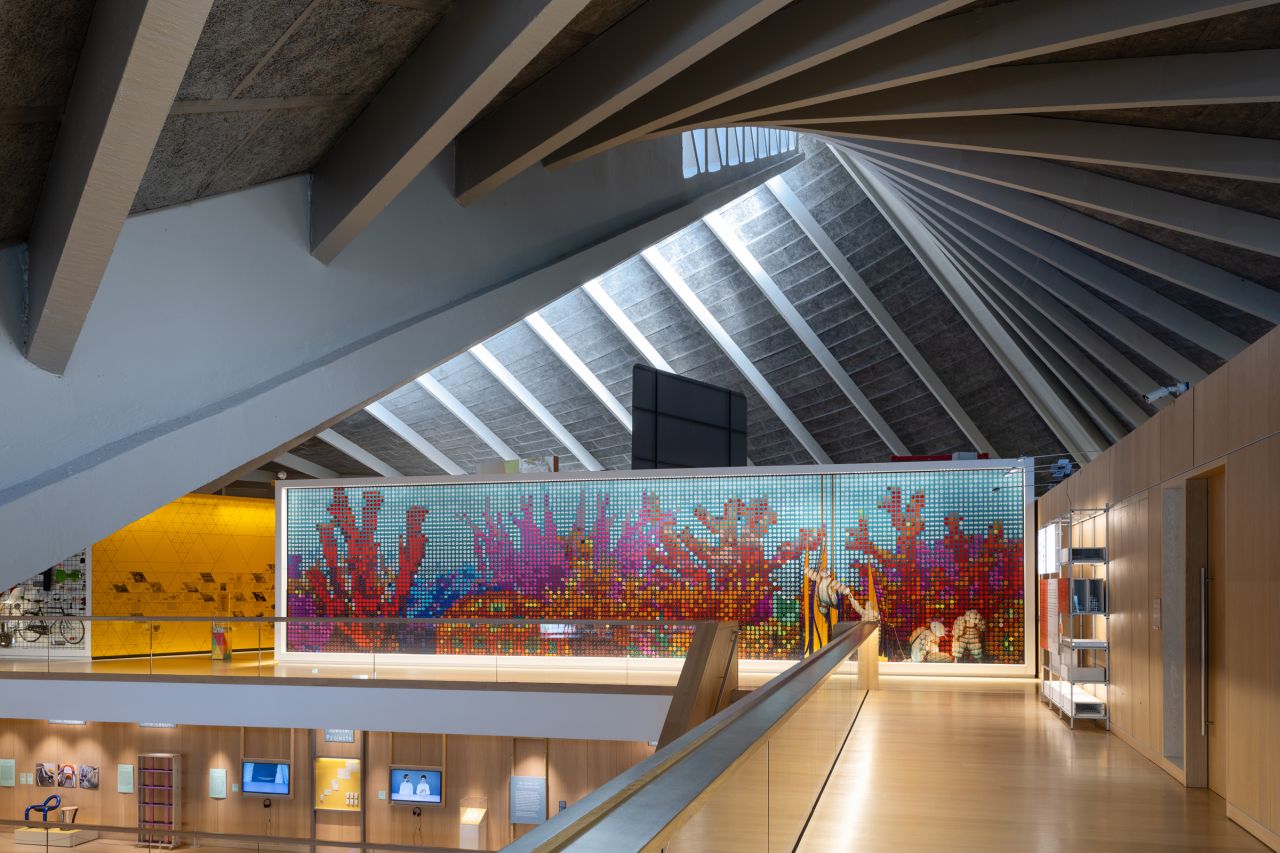Fables for our Time: emojis meet folktales in the Design Museum's new installation
A major new work has moved into the Design Museum's iconic atrium space. Read on to discover the thinking behind it.

Fables for our Time at the Design Museum. © Rob Harris for the Design Museum
If you're ever in London, the Design Museum is a great place to visit for creative inspiration or just a fun and interesting day out. Located on Kensington High Street, his multifaceted museum sees itself as an ever-changing space for the public, industry, and education to come together and explore new ideas. And if you haven't been there for a while, here's a fresh excuse to pop along.
For the last eight years, the second floor of the museum has placed host to a wonderful installation by Morag Myerscough titled Designer Maker User.
But now it's time for a change, and a fantastic new public commission has taken its place.
Thriving ecosystem
Fables For Our Time is a 15m triptych that uses folktales and a new collection of emojis to examine humanity's relationship with the natural environment.

Fables for our Time at the Design Museum. © Rob Harris for the Design Museum

Fables for our Time at the Design Museum. © Rob Harris for the Design Museum

Fables for our Time at the Design Museum. © Rob Harris for the Design Museum
The installation features three panels, each telling a particular story about an ecosystem vital to a thriving planet. The three scenes cover the ecosystems of bees, coral, and mushrooms. These stories are presented as contemporary folktales, with narrators in the foreground who advocate for the primacy of natural systems.
The panels, which consist of 176 constantly rotating prisms, were created by architecture and design studio Space Popular (Lara Lesmes and Fredrik Hellbergin) in collaboration with architectural historian Shumi Bose.
Each panel comprises hundreds of emojis, all designed specially for this commission, arranged in a mosaic-like pattern. They represent both natural and human systems, from cells and species to pesticides and waste. There is insect, plant and marine life alongside batteries, cigarette butts and Wi-Fi symbols.

Fables for our Time at the Design Museum. © Rob Harris for the Design Museum

Fables for our Time at the Design Museum. © Rob Harris for the Design Museum

Fables for our Time at the Design Museum. © Rob Harris for the Design Museum
The first frieze shows an expanse of flowers, representing the work of bees, the crucial pollinators who cooperate with flowers to help them reproduce. The next panel shows a coral reef that is being maintained by a group of divers. Then, the final panel shows the world of mushrooms and their root networks (mycelium).
Animating each frieze are the storytellers, who appear in the foreground and narrate or perform stories about their ecosystems. By wearing animal masks, they embody non-human actors in their tales: a fox, a mouse, a turtle, and an axolotl.
Concept and commission
The idea is that visitors can contemplate the installation from different vantage points within the museum and think about how humans are entangled with the natural environment in ways that are both healing and harmful. The closer you get, the more the triptych reveals.

Fables for our Time at the Design Museum. © Rob Harris for the Design Museum

Fables for our Time at the Design Museum. © Rob Harris for the Design Museum

Fables for our Time at the Design Museum. © Rob Harris for the Design Museum
"We chose folktales as the core of this commission because they have long acted as a means to share cautionary tales," says Fredrik. "And the climate crisis is, in a way, a crisis of storytelling as it is hard to convey the immensity or scale of ecological change. The 21st century needs a new set of fairy tales to imagine how we might design today's planetary possibilities together."
The work was commissioned by Future Observatory, the Design Museum's national research programme for the green transition, which is exploring 'more-than-human design' as a way to reconnect to other species and the ecosystems that keep the planet healthy. (A major exhibition along these lines is planned for 2025.)
Funding was received from the Arts and Humanities Research Council, part of UK Research and Innovation.

Fables for our Time at the Design Museum. © Rob Harris for the Design Museum

Fables for our Time at the Design Museum. © Rob Harris for the Design Museum

Fables for our Time at the Design Museum. © Rob Harris for the Design Museum
As Future Observatory's Director Justin McGuirk explains: "The green transition is a core part of the Design Museum's mission, and it's not just about carbon emissions, it's about reconnecting to the living world. The stories we tell are central to that reconnection, and Fables For Our Time puts natural systems at the heart of the museum.
"It is such a rich work of graphic communication that encourages visitors of all ages to contemplate the role of other species in humanity's story. The work is so detailed that the more you engage, the more it reveals. It is stunning, and we are thrilled that hundreds of thousands of visitors will get to enjoy it for free."
Further Information
Fables for our Time is now open at the Design Museum, at 224-238 Kensington High St, London W8 6AG, United Kingdom, and is free to visit.




 by Tüpokompanii](https://www.creativeboom.com/upload/articles/58/58684538770fb5b428dc1882f7a732f153500153_732.jpg)


 using <a href="https://www.ohnotype.co/fonts/obviously" target="_blank">Obviously</a> by Oh No Type Co., Art Director, Brand & Creative—Spotify](https://www.creativeboom.com/upload/articles/6e/6ed31eddc26fa563f213fc76d6993dab9231ffe4_732.jpg)
















